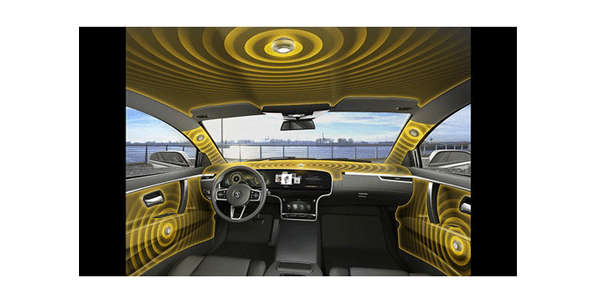There’s no need for a traditional woofer and tweeter in a new type of sound system developed by major car supplier, Continental.
Instead, the system uses the car’s headliners, A-pillars and other parts to act as vibrating “speakers.”
Continental says it is “reinventing the car audio system” by replacing conventional loudspeakers with actuators that create sound by vibrating certain surfaces in the car.
Where some car companies are adding 10 to 30 speaker sound systems, Continental’s approach is in direct opposition. It’s actuators use a magnet and coil to oscillate car surfaces instead of a cone.
Certain areas of the car are suited to producing certain frequencies. The A-pillar can generate high frequencies and the door panels generate mid range frequencies while the roof lining or rear shelf can produce bass.
Continental said, “conventional high-end car audio systems can easily require between ten and 20 or more speakers. Owed to the design of a conventional speaker this gives the system a weight of at least up to 15 kilograms [33 lbs] with a total box volume of ten to 30 liters. Continental’s speaker-less audio system can weigh as little as 1 kilogram [2 lbs] and requires as little as 1 liter of total box volume.”
Continental claims the system produces a more natural 3D sound experience.
It plans to show the system, called Ac2ated Sound at the Frankfurt Motor Show, according to New Atlas.
(Thanks Paul P!)










Ill stick with my Diamond D3 8’s and Hertz Mid’s and High’s lol
I dont quite think this is going to please the auidolphil. The sound will be muffled, a few car manufactures are moving tord using expanding foam inside voids to stiffen up an automobile and score more on crash test, because it makes the body of the car absorb more of the force of impact, this also gives the opertunity to lower the curb weight, and conserve fuel consumption. Your not going to vibrate a body panel with what amounts to dinamate as its body. Survo driven drivers have been around sence WwII on ships, we use them in theater systems for low end rumble, and arua bass shakers used to be made for cars in place of subwoofers, I’ve installed them. They didnt sound bad. But it wasn’t high end audio quality. About 20 years ago somone was working on vibrating crystals in place of loudspeakers. I’m looking around I dont see them now do I. Auto makers go for what’s cheep, speakers are cheep, it doesn’t cost more to punch a hole for a speaker in a metal panel, this idea will cost more money. Why change?
Hard to believe
It should be great for talk radio!
Its been done and never very successful. If we continue to promote this type of thing as accepted or lucrative these “idea” will just continue to drive our ever declining aftermarket 12V industry farther down..
Sound Quality will be an issue as large surfaces don’t lend themselves to pinpoint accuracy, especially in the high frequency arena !
There is little new here. In fact, this has been done before with headliners. Actuators have been around a long time. Anyone remember BES speakers from the 70s and NXT? Both used actuators
What will be interesting will be to see how they’ve dealt with the various poor propagation and distortion issues which is why so many drivers use differing materials. I’ll look forward to a listen. It will likely require a good deal of DSP correction.